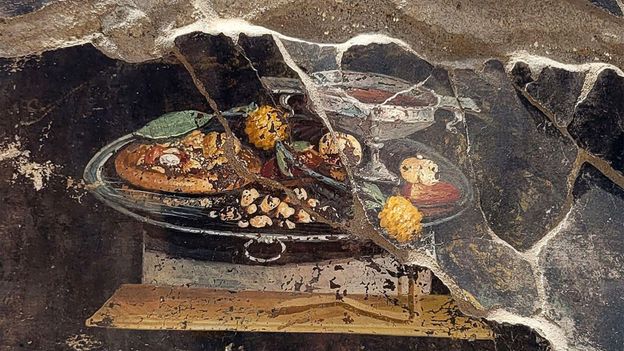Adoreum – the recently discovered Pompeii flatbread fresco

Step 8
After the shells are cooled down, it is time to prepare your toppings. Here you can be creative!
Take 3 figs per flatbread, and mash into a smooth paste. Cover the center platform of each shell with the paste. Add some ricotta or a few small dollops of fig paste to the paste.
Step 9
Slice up some soft fruits, like apricots, dates, or figs, and decorate the top of paste with them. Try using a reedlike tool, like a split wooden stick instead of a blade.
Step 10
Place 2 small quail egg between the slices of fruits and garnish with an apple, apricot or pear.
Warm ⅛ cup of honey and drizzle it over the fruit allowing the trough of the flatbread-shell to fill halfway. If the trough starts to overflow, stop drizzling. Enjoy!
Notes
The Pompeian Adoreum was made using a flour that had been extracted at a certain rate. Use a fine product or a bolted one (bran removed). If you are unable to find emmer flour you may substitute spelt, fine whole or white wheat flour.
If you do NOT have a starter on hand, you can create one by mixing equal parts of flour and warm water with 1 tablespoon of commercial bakery yeast. Stir it and let it rise. Use 35g (¼ cup) of this sponge as your starter.
Pairing notes and tasting notes
Pair this with other items in the fresco, such as citron, red wine and chestnuts. A crumbled, old cheese would also be a great addition to nastos, adoreum or other dishes.
When you try this Roman dessert, keep in mind that it’s not the same as a modern Danish or galette: it’s a rustic honey-cake Roman, topped with seasonal fruit. We can also explore with our mouths and hands the culinary practices and cultural heritage of Pompeii and ancient Rome. It’s a great experience to celebrate this recent discovery, even though we are doing it remotely. Although it’s not pizza, adoreum is still a sight to behold. And a reminder that many of the pastries and baked goods we enjoy today were brought to us by people from many different places, often over oceans. Pompeii, this time.
(Farrell Monaco She is a classical historian, baker, and writer. She is currently an Honorary Visiting Fellow at The University of Leicester School of Archaeology and Ancient History. She was named the 2019 Best Special Interest Food Blog Award winner by Saveur Magazine, and is the author of Panis: the Story of Bread in Ancient Rome.
BBC.com’s World’s Table By changing the way people think about food in the past, the present, and the future, “smash the kitchen ceiling”.
—
Like us and join more than 3 million BBC Travel Fans FacebookFollow us on Twitter or Facebook Twitter The following are some examples of how to get started: Instagram.
This story is for you if you like it. Sign up for the weekly bbc.com Features Newsletter The Essential List” is a list of stories that BBC Future, Culture, Worklife and Travel has selected. Every Friday, you will receive a hand-picked selection from BBC Future, Culture, Worklife and Travel.